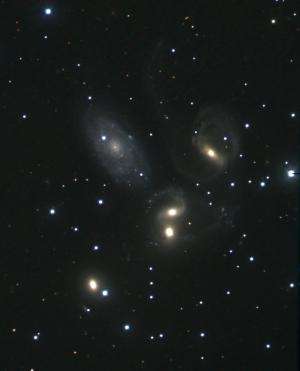Lomonosov Moscow State University opens new observatory in the Caucasus

On Dec. 13 a new astronomical observatory was opened in Russia. It will become the main base for the practice of young astronomers. Also the observatory will allow Russian scientists to conduct fundamental research. The 2.5-meter telescope will become the main instrument of Caucasian Mountain Observatory built by Lomonosov Moscow State University.
In 2006 the Government of Russia has granted 14.2 million Euros for the purchase and the further installation of the new telescope for Lomonosov Moscow State University. The same year scientists and engineers started its construction.
Mount Shatdzhatmaz in the Karachay–Cherkess Republic was chosen as a site for construction. The main criteria for site selection were the results of the astroclimate survey which showed low level atmospheric turbulence and a large number of clear nights.
The surveys showed that the area has mostly clear skies 180 nights per year.
The telescope installed in the observatory has a true Ritchey-Chrétien optical system. Its main mirror was produced and delivered here by the French company REOSC. The dome was built by contractors from Italy. Their Chinese and Danish colleges mounted the telescope and provided the camera for observations. Same time Russian specialists built the observatory itself, controlled the construction of the telescope and conducted acceptance tests of its optical instrument with a Shack-Harman sensor.
"This telescope has the most promising prospects as its optics matches the best in the world and its mirror was made with almost cosmic quality. It is a typical university level modern telescope",—said Anatoly Cherepashchuk, the director of Sternberg Astronomical Institute of Lomonosov Moscow State University (SAI MSU).
"The data analysis showed that the quality of the optics exceeds 0.4", which is close to the diffraction limit. The telescope is very nice. Without no doubt its quality is superior to Russia's largest optical telescopes",—explained Sergey Potanin, senior researcher at Sternberg Astronomical Institute of Lomonosov Moscow State University. Such angular resolution could be compared that achieved in the world largest observatories Paranal (Chile), Roque de los Muchachos (Canary Islands) and Mauna Kea (Hawaii).
In Russia there were only two telescopes with the large mirrors. First of them is the BTA-6 (Big Telescope Alt-azimuth) with a 6 meter mirror. It is located at the Special Astrophysical Observatory in the Karachay–Cherkess Republic. The second one is the Shajn telescope with a 2.6 meter mirror located at the Crimean Astrophysical Observatory.
Two scientific instruments have already been bought for the telescope. The CCD photometer and the IR spectrometer allow the telescope to perform direct imaging, photometry and infrared spectrometry of various astrophysical objects—stars, star clusters, galaxies, etc.
In the future the range of scientific problems solved via the telescope could be extended by the installment of other instruments. Scientists plan to apply adaptive optics methods, which are very popular nowadays in the ground-based astronomy. These methods allow to compensate for jitter buffeting due to turbulence in the Earth's atmosphere.
The new telescope has already served for carrying out the first scientific research. Astronomers used it to perform a photometry of each component of a double star. The angular distance between them is only 1.4 arcsec.
The "First Light" was received at the telescope in mid-November and the quality of the images justified the wildest expectations of the customers who are the astronomers at Sternberg Astronomical Institute of Lomonosov Moscow State University.
"This is a huge success for our astronomers to build such a telescope now. It's modern and it's completely automated. Regular observations will begin in the nearest future",—said Viktor Sadovnichiy, the rector of Lomonosov Moscow State University and the academician of the Russian Academy of Sciences.
The undergraduate and postgraduate programs will be given the priority in the observations. The new observatory will be able to make so-called alertness observations, when the telescope immediately zooms for astronomical object or coordinates which are not provided by the program. The observatory requires a minimum of permanent staff and enables to control the telescope remotely.
"With this telescope we intend to carry extragalactic astronomy observations, to study the physics of stars and to observe the body of the solar system, including asteroids. Students, graduate students and young employees will work hard on this instrument. They will study the nuclei of galaxies and globular clusters. Most importantly they will monitor the variability of different objects, including weak ones",—concluded Anatoly Cherepashchuk.
According to him, one of the advantages of the telescope is its ability to monitor the brightness of objects in different spectral ranges for a long time.
The housing for staff and for the visiting scientists and students has already been built on the territory of the observatory. This will allow to hold Observatory Russian and international scientific conferences on the basis of the observatory.
More information:
www.msu.ru, www.sai.msu.ru
Provided by Lomonosov Science Project